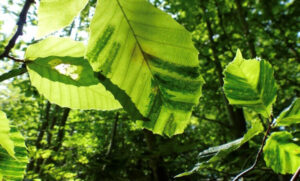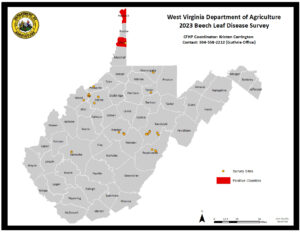
Beech leaf disease (BLD) is a pathogen affecting American beech (Fagus grandifolia), European beech (F.sylvatica), and Oriental beech (F.orientalis). BLD was first discovered in Lake County, Ohio at the Cleveland Metro Park in 2012 and has spread quickly, especially to the east. To date the disease has been detected in fifteen states, including Ohio, Pennsylvania, Michigan, Maryland, Delaware, New Jersey, New York, Connecticut, Massachusetts, New Hampshire, Vermont, Rhode Island, Maine, Virginia, and West Virginia. The disease has also been found in parts of Ontario.
The progression of the disease can vary with the size of trees. In saplings, the progression to severe decline can be quick and mortality has been noted in saplings within two to five years. In larger trees, the progression of the disease may be slower, and it will typically move upwards starting at the lower branches.
Symptoms of BLD have only been noted on leaves and buds. Striping or banding on several leaves on an otherwise healthy appearing tree is the first notable symptom. The striping can be more apparent when viewed from below, and the darkened leaf area will be slightly thicker and raised than the surrounding leaf tissue. Lighter, chlorotic striping may also occur as the disease progresses. The beech trees will begin to show heavily shriveled, discolored, deformed clusters of leaves near the branch tips in the later stages of the disease, and leaf and bud production will also be reduced. Buds that are produced are likely to be attached weakly to the twig and small in size, and mortality has mainly been noted in saplings.

Beech leaf disease is associated with the nematode litylenchus crenatae and research is currently being conducted to determine how the nematode spreads from one area to another.
Surveys for BLD are being conducted by the WVDA and to date, it has been detected in two counties, Hancock and Ohio. The WVDA has also established nine long-term monitoring plots in areas with a high percentage of beech resource.













